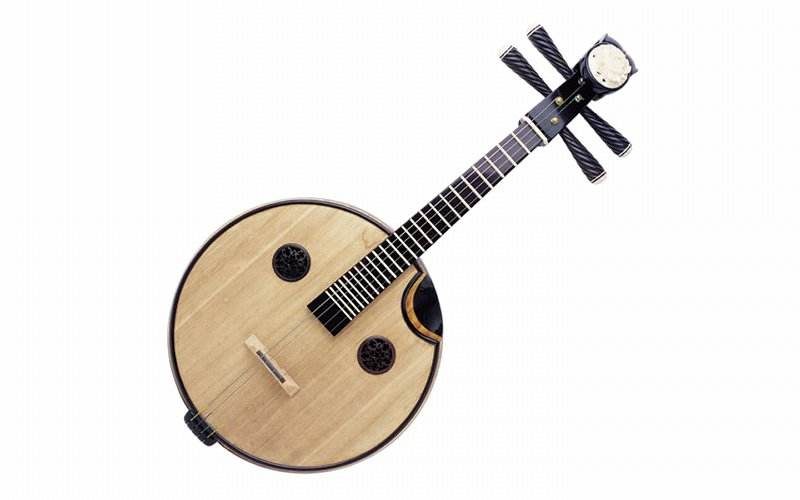The historical development of Zhongruan
1123 views · Organized by 华夫饼 on 2022-02-18
Zhongruan is a Chinese musical instrument with a quiet, soft and poetic timbre, similar to Qin Qin.

In the Qin Dynasty, hundreds of thousands of people built the Great Wall, and they couldn't use shouting to talk. Later, they made a drum, and they knew it was time to eat. Everyone lives together and wants to be entertained, so they put a string on the drum. From this musical instrument, two musical instruments were derived, one is the three-stringed instrument, and the other is the Qin Pipa, which was later made of wood. ,
In the second year of Yuanding, Emperor Wu of the Han Dynasty (115 BC), Zhang Qian sent an envoy to Wusun State, and Wusun King Kunmi intermarryed with Han. Before Princess Wusun got married, Emperor Wu of the Han Dynasty ordered a musical instrument maker to make a musical instrument that could be played on horseback and was easy to carry to relieve Princess Wusun's longing for her long journey. This instrument is "Ruan", which was called "Qin Pipa" in ancient times.
According to legend, Ruan Xian, one of the "Seven Sages of Bamboo Forest" in Wei and Jin Dynasties, was famous for playing the pipa. He completed the reform, so later generations called it "Ruan Xian" or "Ruan Xian Pipa".
During the Tang and Song dynasties, Ruan was very popular, and there were a handful of noble families. The Tang Dynasty poet Bai Juyi once wrote in his poem: "It's not a qin, not a zheng. It's not a zither, but it's not a zither. Don't take the name of Ruan's family. Who knows the ancient tune, and the first time you hear it, it's full of surprises." influence. Song Taizong, the second emperor of the Song Dynasty, could play Ruan, not only that, but also compose music, make musical instruments, and play for ministers.
In the Song Dynasty, Ruan Xian was referred to as Ruan for short, and this name was followed. But Ruan gradually disappeared in the Ming Dynasty, and the Qing Dynasty could no longer find such an instrument, and it was completely lost.
In modern times, at that time, domestic national orchestras already had the "Ruan" musical instrument, but it was not the real Ruan Xian who "originated in Qin and Han Dynasties, prospered in Tang and Song Dynasties, declined and Ming and Qing Dynasties". Ruan's method of making it has been lost for nearly a hundred years.
In 1952, the National Orchestra of the Central Song and Dance Ensemble was established, which was the first domestic professional national band after the founding of New China. The band found photos of Ruan collected in Shoso-in, Japan, and followed the map. The Ruan in the photo has black patterns printed on the body, which was misunderstood as hollow at the time. Therefore, the Ruan made after the founding of the People's Republic of China has a hollow.
Involving musical instruments
Zhongruan (pinyin: zhōng ruǎn) is a national plucked musical instrument with a long history in China. It is a traditional plucked musical instrument of the Chinese nation.
Because of the mellow, rich tone and wide range of sound, Ruan has become the main instrument in solo, ensemble, and duet in ancient times; in modern times, Ruan can play a powerful role in the orchestra, and Da Ruan and Zhong Ruan are mainly used in national orchestras.
Guess you like
Organized by 天井 on 2024-12-23
With the arrival of winter, the temperature drops sharply and the air is dry, and these environmental changes are not small challenges for the traditional plucked instrument of Zhongruan. In order to maintain the best condition and extend its service life, players need to take a series of special maintenance measures.
read >>
Organized by 阿轺 on 2022-09-28
Feng Mantian remembered that when he was a teenager, he spent two cents to buy a ticket to the Beijing Planetarium. That was the first time he walked into the planetarium, and it was the first time he saw galaxies there. It felt very mysterious. A few years ago, he saw the galaxies in the sky for the first time in Guazhou, Gansu. He used a voice to describe the real feeling of that moment - "Wow!"
read >>
Organized by 湛鹰 on 2022-07-26
To celebrate the 25th anniversary of Hong Kong's return to the motherland, Jiangsu Radio and Television Station Wosu.com planned to launch "Hello! "I'm from 1997" series integrates media reports, showing young people's vivid growth stories and wonderful struggle experiences with real lenses and delicate brushstrokes.
read >>
Organized by 没头脑 on 2022-06-17
The experience that music brings to people is very strange. Suddenly, a simple melody brings people into it, whether it is sadness, or joy, or passion, or beauty, as if I suddenly entered a very subtle world, free. Wandering in it, can not extricate themselves.
read >>
Organized by 尘夕 on 2022-06-17
When a person reaches a certain age, he learns to cultivate one's self-cultivation, calm one's emotions, and cherish one's body. There are many ways of self-cultivation, such as walking, writing calligraphy, playing Tai Chi and so on. However, now many elderly friends choose the art of Zhongruan to cultivate their bodies, and the effect is very good.
read >>
 渝公网安备 50010702504639号
渝公网安备 50010702504639号